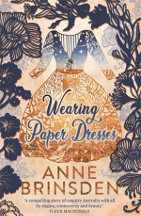Wearing paper dresses by Anne Brinsden

Macmillan, 2019. ISBN: 9781760784850.
(Age: Adult - Adolescent) Highly recommended. This stunning work, a
story of love and terrible loss, and of the struggle to survive,
tells the story of a family who live in on a farm in the Mallee in
the 1950s. The narrative is set in this dry, hard country of
northern Victoria, an area that is so often starved for rain, where
people, Brinsden writes, found survival 'precarious'. When his wife
dies, Pa asks his son and family to move back to the family farm.
While this region of Australia experiences frequent droughts, and
the earth is difficult to farm, Bill is determined to help his
father. It is clear from the start of the story that his wife,
Elise, is not at ease, and her mental state fluctuates wildly, yet
she loves her family and tries to understand the culture of the
countryside. She is angry with the girls, Marjorie and Ruby, whom
she sees as becoming rough and unladylike. Yet we are positioned to
see that her struggle to fit in, to understand the alien culture, is
clearly weakening her mind.
Told from the point of view of Marjorie, one of the daughters, the
narrative creates a world of growing stress, as the family struggle
with the climate, the terrible lack of water, and the tempestuous
nature of the mother's illness. Yet creating and wearing paper
dresses (albeit extraordinarily beautiful ones), even planting
plastic flowers and fake greenery so that at least there is some
colour in the garden, only places her in the 'odd' basket where the
locals are concerned.
We cannot help but be completely drawn into the tragic world of this
family and its heart-rending times, the disasters and the recovery.
When Brinsden writes of the wind, the 'willy-willy feeding on
itself', lurching and swaying in the dust and the heat, crazy and
wild and ruinous and beautiful', her words so reflect so aptly both
the weather and Elise. Her word choice elicits our empathy and
indeed a sense of deep sadness for this family and the world of the
text. She stirs the soul, lifts the emotions and the spirit, yet
enables us to empathise, to feel a deep sense of the heartbreak of
the place and people, and of the triumph of surviving.
Utterly captivating, lyrical and tender, this is storytelling at its
best, and this book is an exciting new narrative that depicts
Australia and its changing culture. Suitable for adolescent and
adult reading.
Elizabeth Bondar